![]()
![]()
![]()
Use LEFT and RIGHT arrow keys to navigate between flashcards;
Use UP and DOWN arrow keys to flip the card;
H to show hint;
A reads text to speech;
157 Cards in this Set
- Front
- Back
- 3rd side (hint)
|
What does knowledge of microbes enable humans to do? |
Prevent food spoilage and disease occurrence |
|
|
|
What are aseptic techniques? |
Steps taken to prevent contamination in medicine and microbiology laboratories |
|
|
|
Describe bacteria |
1. Prokaryotes 2. Peptidoglycan cell walls (Carb and protein) 3. Asexual cell division by binary fission 4. For energy they use organic chemicals, inorganic chemicals, or photosynthesis (symbiotic relationships) |
|
|
|
Describe archaea |
1. Prokaryotic 2. Lack Peptidoglycan 3. Live in extreme environments 4. Kingdom includes: methanogens (methane), extreme halophiles (salinity), extreme thermophiles (temperature) |
|
|
|
describe fungi |
1. Eukaryotes (have nuclear membrane) 2. Chitin cell walls 3. Use organic chemicals for energy 4. Molds and mushrooms are multicellular consisting of masses of mycelia which are composed of filaments called hyphae 5. Yeasts are unicellular |
|
|
|
Describe protozoa |
1. Eukaryotes 2. Absorb or ingest organic chemicals 3. May be motile via pseudopods, cilia, or flagella 4. Live free as a parasite 5. Reproduce sexually or asexually |
|
|
|
Describe algae |
1. Eukaryotes 2. Cellulose cell walls 3. Use photosynthesis for energy 4. Produce molecular oxygen and organic compounds |
|
|
|
Describe viruses |
1. Acellular 2. Consist of dna OR rna core 3. Core is surrounded by a protein coat 4. coat may be enclosed by a lipid envelope 5. Viruses are replicated only when they are in a living host cell
|
|
|
|
Who reported that living things were composed of little boxes or cells |
Robert hooke 1665 |
|
|
|
When were the first microbes first observed |
1673 |
|
|
|
Who in 1673-1723 described live microorganisms that he observed in teeth scrapings, rain water, and peppercorn infusions |
Antoni van Leeuwenhoek |
|
|
|
Who in 1835 showed that a silkworm disease was caused by a fungus |
Agostino bassi |
|
|
|
Who in 1865 believed another silkworm disease was caused by a protozoan |
Pasteur |
|
|
|
Who in the 1840's advocated hand washing to prevent transmission of puerperal fever from one OB patient to another |
Ignaz semmelwise |
|
|
|
Who in 1860's used a chemical disinfectant to prevent surgical would infections after looking at Pasteurs work showing microbes are in the air, can spoil food, and Cause animal diseases? |
Joseph lister |
Listerine |
|
|
Who in 1876 proved that a bacterium causes anthrax and provided the experimental steps, Koch's postulates, to prove that a specific microbe causes a specific disease |
Robert Koch |
|
|
|
Who in 1796 inoculated a person with cowpox virus, the person was then protected from smallpox |
Edward jenner |
|
|
|
What is the word vaccination derived from? |
Vacca for cow |
|
|
|
What is immunity |
Infecting a person with another lesser form of a virus to allow the body to build is resistance to a disease |
|
|
|
What led to the development of the theory of biogenisis |
Beginning with Pasteurs work, discoveries included the relationship between microbes and disease, immunity, and antimicrobial drugs |
|
|
|
Who in 1858 said cells arise from preexisting cells |
Rudolf virchow |
|
|
|
What is the cell theory |
All living things are composed of cells and come from preexisting cells |
|
|
|
What is chemotherapy? |
Treatment with chemicals |
|
|
|
What can chemotherapeutic agents used to treat infectious disease be? |
Synthetic drugs or antibiotics |
|
|
|
What are antibiotics |
Chemicals produced by bacteria and fungi that inhibit or kill other microbes |
|
|
|
What from tree bark was long used to treat malaria |
Quinine |
|
|
|
Who in 1910 developed a synthetic arsenic drug, salvarsan, to treat syphilis |
Paul Ehrlich |
|
|
|
When were sulfonamides synthesized? |
1930s |
|
|
|
Who in 1928 discovered the first antibiotic? |
Alexander Fleming |
|
|
|
What fungus did fleming observe made an antibiotic, penicillin, and what did it kill? |
The penicillium fungus killed staphylococcus aureus |
|
|
|
What is bacteriology |
Study of bacteria |
|
|
|
What is Mycology |
Study of fungi |
|
|
|
What is parasitology |
Study of protozoa and parasitic worms |
|
|
|
What is virology? |
Study of viruses |
|
|
|
What is immunology and what is being studied |
Study of immunity and they study vaccines ans interferons to prevent and cure viral diseases |
|
|
|
What are serotypes and who proposed their existence in 1933 |
Variants within a species and Rebecca lancefield |
|
|
|
What is recombinant DNA? |
DNA made from two different sources |
|
|
|
Who in the 1960s inserted animal DNA into bacterial DNA and the bacteria produced an animal protein |
Paul Berg |
|
|
|
What is microbial ecology |
Bacteria recycle carbon, nutrients, sulfur, and phosphorus that can be used by plants and animals |
|
|
|
What is bioremediation |
Bacteria degrade organic matter in sewage and bacteria degrade or detoxify pollutants such as oil and mercury |
|
|
|
What can microbes that are pathogenic be used for |
Alternatives to chemical pesticides Im preventing insect damage to agricultural crops and disease transmission |
|
|
|
What is an example of a microbe that are fatal In many insects but harmless to other animals including humans and plants? |
Bacillus thuringiensis |
|
|
|
What is biotechnology? |
The used of microbes to produce foods and chemicals, ex: production of insulin = lower costing source for diabetics |
|
|
|
What is genetic engineering |
New technique for biotechnology |
|
|
|
What are examples of genetic engineering? |
Bacteria and fungi can produce a variety of proteins including vaccines and enzymes and genetically modified Bavteria are used to protect crops from insects and from freezing |
|
|
|
What is gene therapy |
Missing or defective genes in human cells can be replaced |
|
|
|
Why are the words flora and microflora used to describe bacteria? |
Bacteria was once classified as plants |
|
|
|
What term has replaced flora? |
Biota answer microbiota which reference all microbes in and on the human body |
|
|
|
What is the function of normal microbiota |
Their presence inhibits the growth of pathogens They aid Im resistance which is the ability of the body to Ward off disease Many of them produce growth factors such as foliage acid and vitamin k and b |
|
|
|
What are resistance factors? |
Skin, stomach acid, and antimicrobial chemicals |
|
|
|
What are infectious diseases? |
When a pathogen overcomes the hosts resistance and disease results |
|
|
|
What are eid s? |
Emerging infectious diseases: new diseases and diseases increasing in incidence |
|
|
|
What are the most useful units in microbiology |
1 micrometer um = 10^-6 m =10^-3 mm I nanometer nm =10^-9m =10^-6 mm 1000 nm= 1 um 0.001 um = 1 nm |
|
|
|
What is total magnification |
Objective lens × ocular lens |
|
|
|
What is a compound microscope? |
An image from the objective lens is magnified again by the ocular lens |
|
|
|
Know these parts |
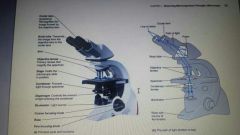
|
|
|
|
What is resolution? |
The ability of a lens to distinguish 2 points |
|
|
|
How far apart can a microscope with a resolving power of .4 nm distinguish points? |
Points that are >\= .4 nm apart |
|
|
|
What type of light provides greater resolution |
Shorter wavelengths of light provide greater resolution |
|
|
|
What type of microscopy uses long wavelengths and what does this limit the resolving power to? |
Bright field, about .2um |
|
|
|
What is refractive index? |
The light bending ability of a medium |
|
|
|
What happens of light bends in air too much? |
It may miss the small high- magnification lens |
|
|
|
What is used to keep light from bending? |
Immersion oil |
|
|
|
How is immersion oil like glass? |
It has the same r. Refractive index |
|
|
|
What does brightfield mean? |
Dark objects are visible against a bright background |
|
|
|
In brightfield what happens to the light? |
Light reflected off the specimen does not enter the objective lens |
|
|
|
Why is brightfield not recommended for unstained specimens? |
Stain changes the refractive index and increases contrast between light and dark objects, a step that is necessary for bright field viewing |
|
|
|
What is darkfield illumination? |
Light objects are visible against a dark background |
|
|
|
In darkfield what happens to the light. |
Light reflected off the specimen enters the objective lens |
|
|
|
What is the main action of darkfield microscopy? |
It requires blocking out of the central light that ordinarily passes through and around the specimen allowing only those rays converging at oblique angles to strike the specimen |
|
|
|
What is dark field microscopy good for? |
Viewing specimens that can not be stained for various reasons and useful for observing unstained specimens suspended in liquid |
|
|
|
What is a phase contrast microscope? |
Enables observation of internal structure, does not require staining to view the slide, enables observation of living specimen |
|
|
|
What is a differential interface contrast microscope? |
Uses two beams of polarized light to enhance the contrast in unstained samples, gives optical density |
|
|
|
What is fluorescence? |
Uses uv light, fluorescent substances absorb uv light and emit visible light. Cells can be stained with fluorescent dyes called fluorochromes |
|
|
|
What is confocal illumination? |
Uses fluorochromes and a laser light. The laser illuminates each plane in a specimen to produce a 3d image. |
|
|
|
What is a scanning acoustic microscope? |
Interprets the action of a soundwave through a specimen. Used to study living cells attached to another surface |
|
|
|
What are electron microscopes |
Used for objects smaller than .2um such as viruses or internal structure of cells. Uses electrons |
|
|
|
Describe transmission electron microscopy |
Electrons pass through the specimen and are scattered magnetic lenses focus the image onto fluorescent screen or photographic plate used to view different layers of specimens, kill the specimen |
|
|
|
What does a scanning electron microscope do? |
3 d view of specimens. On the surface. Useful in studying surfave structures of intact cells and viruses |
|
|
|
What is a scanned probe microscope |
Uses probes to examined the surfave of a specimen using an electrical current. Used to map atomic and molecular shapes, characterize magnetic and chemical properties, and determine temperature variations |
|
|
|
What is a scanning tunneling microscope? |
Used to provide detailed views of molecules such as dna |
|
|
|
What is atomic force microscopy? |
Used to image both biological substances and molecular processes |
|
|
|
For microscopes look at table 3.2 on pg 65 |
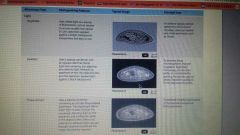
|
|
|
|
What is a smear? |
Thin film of a solution of microbes on a slide |
|
|
|
How is a smear made? |
Usually air dried prior to fixing or staining, usually fixed to attach the microbes to the slide and kill the microbes either using a flame or methanol |
|
|
|
What do stains consist of? |
A positive and negative ion |
|
|
|
How are stains chosen? |
According time the Ph of the bacteria, most are negatively charged at Ph 7 |
|
|
|
Describe a basic dye |
The chromophore is a cation, it's attracted to negative bacteria, crystal violet, safranin, methylene blue, and malachite green |
|
|
|
Describe an acidic dye |
The chromophore is an anion, used to stain the background (negative staining), useful when cell morphology is important ans distortion by fixing is undesirable, ex: eosin, acid fuchsin, nigrosin |
|
|
|
What is a simple stain? |
Use of a single basic dye and used to enhance the general shape or structure |
|
|
|
What is a mordant |
May be used to hold the stain or coat the specimen to enlarge it. Increases the affinity of stain for specimen, increases bulk of specimen |
|
|
|
What is a gram stain? |
Classifies bacteria into gram positive or gram negative and based on the Peptidoglycan layers of the cell |
|
|
|
Characterisitcs of gram positive bacteria |
Tend to be killed by penicillin and detergents |
|
|
|
Characterisitcs of gram negative bacteria |
Resistant to antibiotics |
|
|
|
What are the colors of gram positive and negative bacteria? |
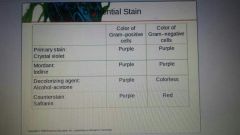
|
|
|
|
What is the staining procedure |
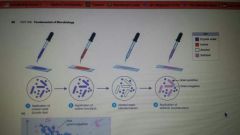
|
|
|
|
Describe acid fast staining |
Some bacteria have a waxy lipid, mycolic acid in their cell wall making it more durable and associated with pathogens. The stain carbol fuschin must be driven into the cells with heat, cells are discolored with acid alcohol.and it will work on all but acid fast bacteria |
|
|
|
What is negative staining? |
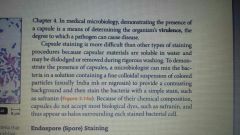
Used for capsules, useful in determining virulence |
|
|
|
What is endospore staining? |
Heat required time drive a stain into endospores- schaeffer - fulton endospore stain |
|
|
|
Describe flagella staining? |
Requires mordant to make flagella wide enough to see |
|
|
|
What are the cell shapes? |
Coccus- sphere Bacillus- rod Spiral- spiral Coccobacilli - combo |
|
|
|
What are some unusual shapes? |
Stella - star shaped Haloarcula - square |
|
|
|
What are the variations of spirals? |
Vibrios- curved rod like Spirilla - helical rigid body Spirochetes - helical flexible body |
|
|
|
Most bacteria are _________ having one morphology or shape, some are ________ having more than one shape depending on conditions |
Monomorphic, polymorphic |
|
|
|
What are some arrangements of bacteria? |
Pairs: diplo Chains: strepto Groups of 4 in 2 planes: tetrads Groups of 8 in 3 planes: sarcinae Clusters in multiple planes: staphylococci |
|
|
|
What is glycocalyx? |
Found primarily in Eukaryotes and found outside cell wall if one exists, usually sticky |
|
|
|
What is a capsule and what is it's purpose? |
Neatly organized glycocalyx and prevent phagocytosis |
|
|
|
What is a slime layer? |
Unorganized and loose glycocalyx |
|
|
|
What is an eps? |
Extracellular polysaccharide that allows cells to attach |
|
|
|
Describe flagella |
Located outside cell wall, longer than cilia, 9+2 arrangement, made of chains of flagellin, attached to a protein hook, anchored to the wall and membrane by the basal body |
|
|
|
When flagella rotate counter clockwise they _____, when they rotate clockwise, the bacteria ______ |
Run, tumble |
|
|
|
What are the different types of flagella? |
Atrichous - No flagella Peritrichous - distributed over the entire cell Polar- at one or both ends of the cell If polar the may be Monotrichous - a single flagellum at one pole Lophotrichous - a tuft of flagella coming from one pole Or amphitrichous - flagella at both poles of the cells |
|
|
|
What is a run? |
Unidirectional movement |
|
|
|
What is a tumble? |
Periodic and abrupt changes in direction |
|
|
|
What is taxis? |
Movement toward or away from stimuli |
|
|
|
What are two types of taxis? |
Chemotaxis, phototaxis |
|
|
|
The flagellar protein ______ is used to distinguish variations within species of gram negative bacteria called ______ |
H antigens, serovars |
O157:H7 |
|
|
What are axial filaments? |
The mechanism of spirochete movement, also known as endoflagella, they are fibril bundles that wrap around the cell anchored at one end of the cell and rotation causes the cell to move. |
|
|
|
Where are fimbriae and pili found? |
Gram negative bacteria |
|
|
|
Describe fimbriae |
they are numerous and They allow attachment, for example neisseria gonorrhoeae attach to mucous membranes |
|
|
|
Describe pili |
They are few in number, they are used to transfer dna from one cell to another |
|
|
|
Describe the cell wall |
Prevents osmotic lysis, made of different materials in different microbes |
|
|
|
What is Peptidoglycan |
Cell wall in gram positive Bacteria Polymer of disaccharide NAG N- acetylglucosamine, and N- acetlymuramic NAM Liked by polypeptides |
|
|
|
What are three types of gram negative cell walls? |
Lipopolysaccharides, lipoproteins, and phospholipids. |
|
|
|
Describe gram negative cell walls |
Forms the periplasm between the outer membrane and the plasma membrane, provides protection from phagocytes, complement and antibiotics, contains the O polysaccharide antigen (O157: H7) |
|
|
|
What Is lipid a |
An endotoxin (part of through outer portion of the cell wall that is released when bacteria die ) |
|
|
|
What are teichoic acids? |
In gram positive cell walls, lipoteichoic acid links to plasma membrane, on the wall teichoic acid links to Peptidoglycan. It may regulate the movement of cations |
|
|
|
Compare and contrast gram positive cell walls to gram negative cell walls |
Positive: thick Peptidoglycan, teichoic acid, and in acid fast cells - contains mycolic acid Negative: thin Peptidoglycan, No teichoic acids, outer membrane |
|
|
|
Describe the cell walls of mycoplasmas |
Lack cell walls, cell membrane has pumps to maintain proper osmotic pressure, their cell membranes contain different sterols that help in stabilization |
|
|
|
Describe the cell walls of archaea |
Wall less or walls of pseudomurein (lack NAM and NAD) |
|
|
|
Describe the cell walls of acid fast bacteria |
Mycobacteria, hydrophobic waxy lipid mycolic acid bound to external thin Peptidoglycan layer, very sticky and durable |
|
|
|
What does a lysozyme do to damage cell walls? |
Digests disaccharide in Peptidoglycan |
|
|
|
How does penicillin damage cell walls? |
Inhibits peptide bridges in Peptidoglycan |
|
|
|
What does osmotic lysis do to damage cell walls |
Damages protoplasts and spheroplasts |
|
|
|
What is a protoplasts? |
Wall-less cell |
|
|
|
What are spheroplasts |
Wall-less gram positive cell |
|
|
|
What are L forms? |
WAll less cells that swell into irregular shapes |
|
|
|
What is edta? |
Ethylemediaminetetraacetic acid weakens the ionic bonds in the outer membrane and thereby damages it, which gives the lysozyme access to the Peptidoglycan layer |
|
|
|
Describe the components of the plasma membrane |
Phospholipid bilayer, peripheral proteins, integral proteins, transmembrane proteins, glycoproteins and glycolipids project from the surface and provide protection and facilitate communication Glycoproteins may be involved in infectious diseases |
|
|
|
Describe the fluid mosaic model |
Membrane is as viscous as olive oil, proteins must move to function, phospholipids rotate and move laterally, entire membrane is self sealing |
|
|
|
Describe components of the plasma membrane |
Selectively permeable, where nutrient catabolism takes place, enzymes for atp production, photosynthetic pigments on foldings called chromatophores or thylakoids, mesosomes(not sure of what they are or how they are produced ) |
|
|
|
What can Cause damage to the plasma membrane? |
Alcohols, quatemary ammonium (detergents), and polymyxin antibiotics Cause leakage of cell |
|
|
|
Describe simple diffusion |
Movement of a solute from an area of high concentration to low concentration, continues until equilibrium is reached, passive process |
|
|
|
Describe facillitated diffusion |
Solute combines with a transporter protein (permease) in the membrane, No energy used by the cell, follows passive diffusion, provides movement of small organic ions that are repelled by the nonpolar lipid tails, nonspecific selection of substance in Prokaryotes, extracellular enzymes will break down large substances before transporters can pass the material |
|
|
|
Describe active transport |
Substances that require a transporter and atp |
|
|
|
Describe group translocation |
Requires a transporter protein and a pep (phosphoenolpyruvic acid) Also called phosphotransferase system and pep group translocation Used by bacteria for sugar uptake where the source of energy is from pep , example in ecoli |
|
|
|
Describe the cytoplasm |
Everthing enclosed by the cytoplasmic membrane, about 80% water, contains dna and rna, enzymes and amino acids, carbohydrates, lipids, inorganic ions, many low molecular weight compounds, liquid component is called cytosol, some groups of bacteria produce cytoplasmic inclusion bodies that carry out specialized cellular functions |
|
|
|
Describe the nuclear area |
Bacterial genome is composed of chromosomal deoxyribonucleic acid, represents the bacteriums nucleiod, No nuclear membrane or nucleoli, nucleiod is one long single molecule of double stranded helical supercoiled dna, in most bacteria the two ends of the dna bond together to form a physical and genetic circle |
|
|
|
Describe ribosomes |
Composed of ribosomal rna and protein, composed of 2 subunits (30s 50s) function as a workbench for protein synthesis(several antibiotics work by inhibiting protein synthesis ) |
|
|
|
Describe inclusions |
Cyanophycin - cyanobacteria contain large inclusion bodies that store nitrogen for the bacteria CArboxysomes - cyanobacteria, thiobacilli, and nitrifying bacteria possess bodies containing an enzyme use for co2 fixation Gas vacuoles - purple and green photosynthetic bacteria contain hollow protein cylinders enabling the organism to regulate buoyancy Metachromatic or volutin granules store phosphate Sulfur granules that store sulfur Poluhydroxybutyrate granules or glycogen granules function as an energy reserve Magnetosomes - motile aquatic bacteria are able to orient themselves by responding to magnetic fields using membrane bound crystals or magnetite Iron oxide is produced by a few gram negatives lyses hydrogen peroxide |
|
|
|
Describe endospores |
Resting cells resistant to desiccation heat, and chemicals bacillus and clostridium |
|
|
|
What is sporulation |
Endospore formation |
|
|
|
What is germination |
Return to vegetative state |
|
|
|
What does the proteinaceous coat do? |
Provides much of the chemical and enzymatic resistance |
|
|
|
What is the cortex? |
Thick layer of specialized Peptidoglycan under the proteinaceous coat |
|
|
|
What is the germ cell wall |
Resides under the cortex, this layer of Peptidoglycan will become the cell wall of the bacterium after the endospore germinates |
|
|
|
What is the center core |
Exists in a dehydrated state and houses DNA ribosomes and large amounts of dipicolinic acid which serves either to stabalize DNA or assist in heat resistance |
|

